The LG G4 Review
by Joshua Ho on July 30, 2015 10:00 AM EST- Posted in
- Smartphones
- Qualcomm
- LG
- Mobile
- Snapdragon 808
- LG G4
Display
One of the major points of emphasis for us in the smartphone space continues to be display, as even though you can replace a display on a phone, the only real reason to do so is if you shatter the glass cover of the display. As a result, on pretty much any device it becomes critical to get this aspect of the device right from the very start with little to no end user intervention. Issues like low maximum brightness, poor contrast, poor viewing angles, poor color and/or contrast stability, and all kinds of other problems can severely compromise a smartphone experience. At the high end, there’s increasingly less room for these kinds of issues, especially as companies like Samsung and Apple are shipping almost flawless displays at this point in the smartphone industry.
The problem is that it’s hard for people to really agree on what makes a great display at times. Some people want the vivid and colorful display possible, while other prefer accurate color reproduction. Some people want a cold color cast, while others prefer if a display is warm.
There are certain performance characteristics where it is obvious that more or less is better, like peak brightness, contrast, color and contrast stability with viewing angles, resolution, and power efficiency. However, for color calibration we elect to test against the standard sRGB gamut with a D6500 white point and power 2.2 gamma as it’s likely that most web content will be targeted to those standards. We will make a reasonable effort to ensure that a display is set to an appropriate mode that would get close to sRGB, but we will continue to draw the line at anything that requires a colorimeter such as an arbitrary color balance and/or gamut slider. In order to measure the calibration error, we use SpectraCal’s CalMAN 5, along with X-Rite’s i1Pro2 and i1Display Pro.
In the interest of exploring the G4's display further this time around, we'll also test the G4's display against the DCI gamut. DCI stands for Digital Cinema Initiatives, and this group sets various standards for resolution and color for various equipment in the film industry. This includes a gamut, which is noticeably wider than sRGB, and also has a different white point and gamma standard. As a result, what is accurate for sRGB is completely inaccurate for DCI's gamut and vice versa. This is done because LG is claiming that the G4 supports the DCI gamut, which is accomplished by new backlight phosphors that allow for more pure red and green light to be emitted from the display. Presumably, because the DCI gamut is used in the movie industry, movies watched on a display supporting DCI gamut will look more accurate.
In the case of the G4 though, it's likely that LG wants to really show off the wider gamut that their new LCD can enable, which is why we're seeing an attempt to cover the DCI v1.2 gamut. After all, if they've put the work into a display that can enable wider gamut, it would probably be a waste to then constrain it to sRGB for every shipping configuration.
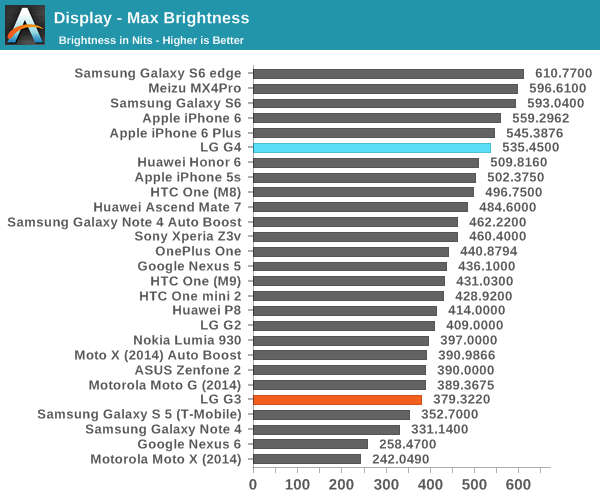

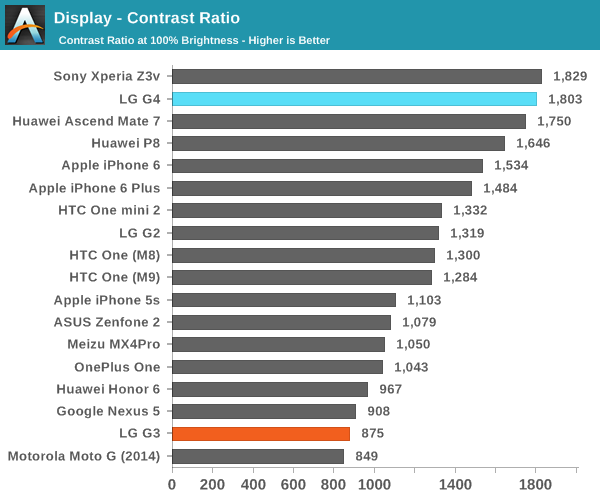
Our first test focuses on simple brightness and contrast at the highest brightness level. In this test, LG has managed to significantly improve their display over the G3, which puts the G4’s LCD at a somewhat average level for smartphones. It isn’t quite as high as the iPhone 6 or the Galaxy S6, but given the much higher subpixel density it’s an amazing showing and comparable to other smartphones that have stayed at 1080p.
Black levels are relatively low though, and the result is a surprisingly high contrast level for an LCD which remained around the same level even when using APL-constant patterns to defeat dynamic contrast at roughly 1500:1 static contrast. This was probably one of the first things that I noticed when using the LG G4, as the G3 in comparison was far more washed-out in just about every situation.
It seems that these improvements have been enabled with the use of photoalignment technology, which shares similarities with photolithography but attempts to induce anisotropy in a photoresist analogue on a glass substrate, which then influences the orientation of the deposited liquid crystals in the LCD. In daytime I didn’t have issues reading the display, although it isn’t as easy to read as the S6’s display with auto boost mode enabled.
While we’re still on the subject of contrast and color shifting, in my experience the LG G4’s display didn’t have any noticeable issues with wash-out unless you stare at a black image, and subjectively colors stay true to the eye in just about every viewing angle. The display is also laminated close to the glass, which makes the phone look like the display is painted on when you look closely at most images from extreme viewing angles. LG has also eliminated the rather annoying sharpening effects from the display, which counts as a pretty dramatic improvement in my book for readability as the sharpening effects on the G3 were incredibly annoying with extended reading.
sRGB
DCI
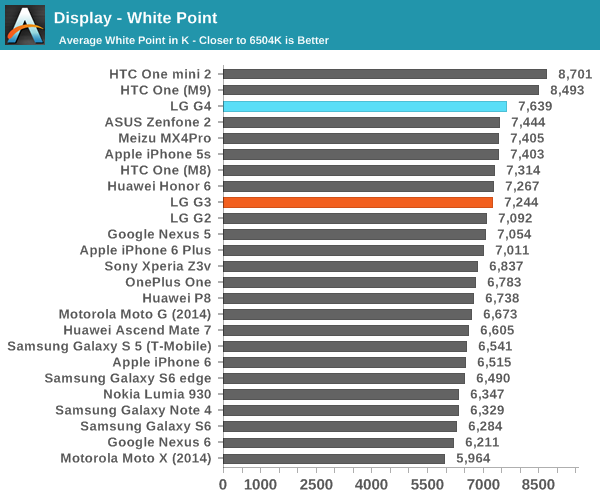
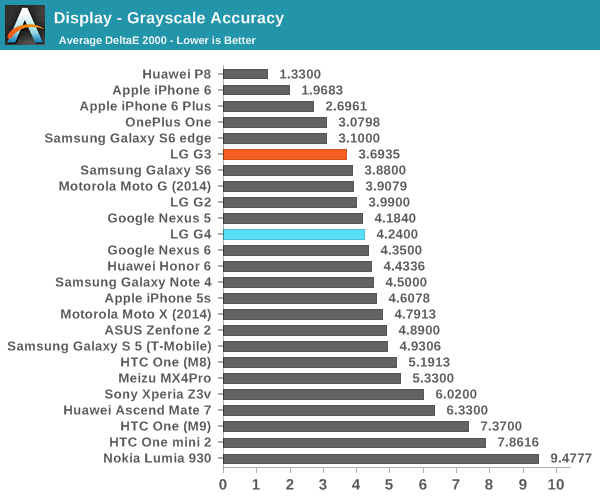
Moving on to the grayscale portion of the test, things get a bit less rosy. The G4’s display has a pretty strong blue cast to it much like the One M9, although gamma is relatively consistent if slightly low for presumably better shadow detail. I suspect this is partially done to improve peak brightness output and partially because a segment of end users prefer a cold display, but LG could improve their standing in this test by adding a toggle to set warm, neutral, and cold white points. As the DCI 1.2 gamut needs power 2.6 gamma and a relatively balanced white point, the G4 will have some problems with accurate rendition of grayscale with DCI content.
sRGB
DCI
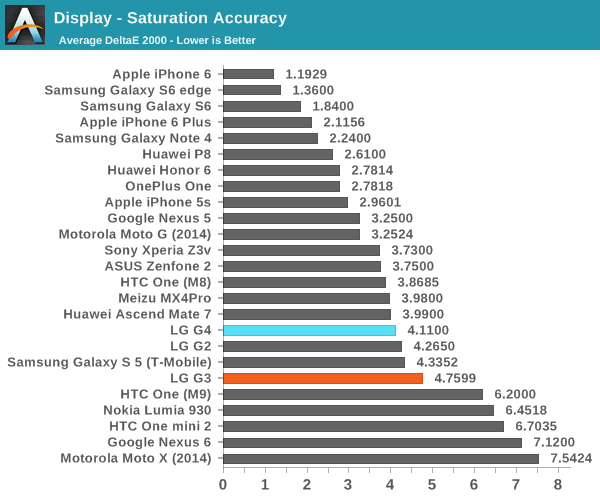
Looking at the saturation sweep for the display, we can immediately tell that the G4 misses the sRGB colorspace. However, the way this is done is rather uneven. On the red and magenta sweep, the color is correct up to 80% and it’s somewhere between 80 and 100% where the display will exceed sRGB. However, colors like cyan and green don’t do saturation compression, so the error from sRGB is evenly spaced. Blue ends up meeting sRGB pretty closely here despite saturation compression, which is an improvement from the significant saturation compression of the G3 display. Unfortunately, the excessively wide gamut results in a relatively average/poor showing in this test. Even when I target the DCI gamut, the issues with gamma and general calibration issues means that the average dE2000 error is roughly double that of the sRGB average dE2000 error at 8.89.
sRGB
DCI

As one might have guessed from the previous two results, the end result for the LG G4 is that color accuracy isn’t quite as good as one might have hoped. Due to an excessively wide gamut and a cold color cast, the G4’s display ends up slightly disappointing. Even when we target the DCI gamut for testing, the G4 falls short as the calibration is closer to the sRGB settings that we use than DCI with an average error of 9.72. However, the panel itself is high quality given the high contrast, relatively high peak luminance, and great viewing angles. As-is, it’s close to the Galaxy S6 and iPhone 6 Plus for display quality, but falls short due to lack of calibration. I think the solution here would be for LG to provide an sRGB toggle that would set white point to target 6504k and sRGB colorspace, but this would have to start with the LG G5 as it’s too late at this point to meaningfully change things here.


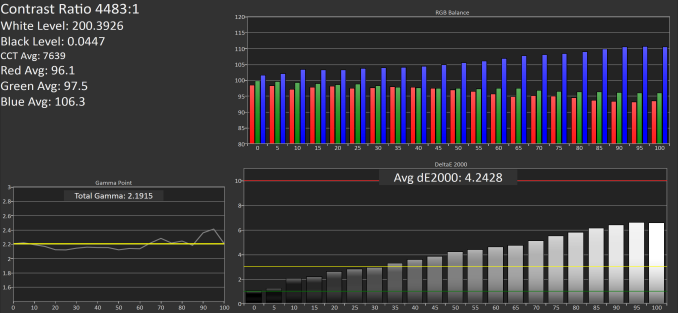
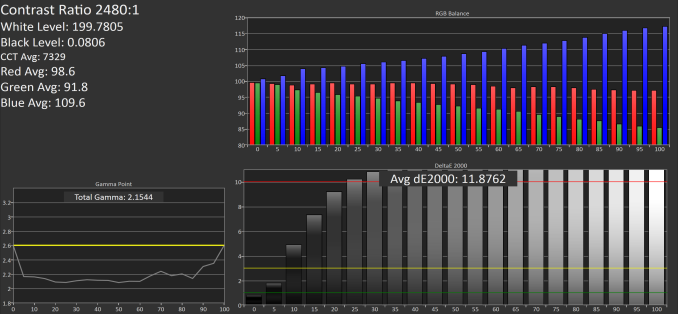
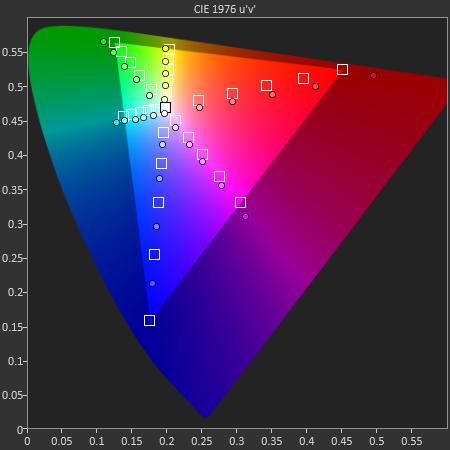


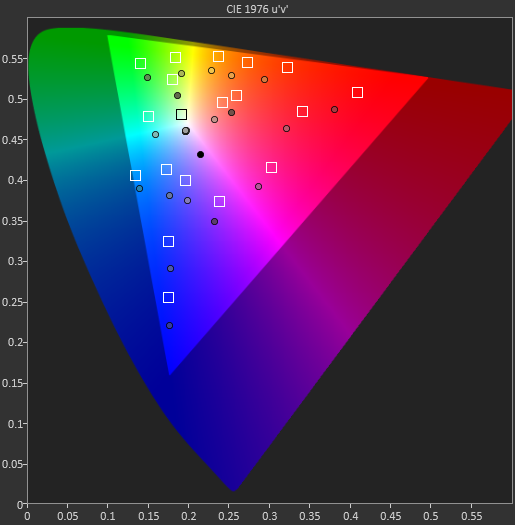








84 Comments
View All Comments
djc208 - Thursday, July 30, 2015 - link
I had the original Optimus G, and it was a great phone hardware wise, but my biggest problem with LG has been their software support. It's getting better but still miserable. They move to new phones so fast that most are barely supported for software for a year. Meanwhile I think Samsung has done a better job of updating and supporting older phones, plus they're so popular the ROMs are more plentiful and well supported. I just couldn't get over the Samsung bloatware, but if you can, they're so close it would probably tip me toward the Samsung based on better software support long term.djw39 - Thursday, July 30, 2015 - link
For the software, if they would just allow for the notification toggles to be hidden by default and appear with a second swipe down, I think that would go a long way. Maybe also give us a normal lockscreen clock too.phoenix_rizzen - Thursday, July 30, 2015 - link
That's my biggest complaint with LG's UI: the lack of usable space on the notification drop-down. There's a scrollable row of quick-toggles, then the volume slide, then the brightness slider, then the shortcuts bar for their quick apps (or whatever they call them), and then, using the last inch of the screen, the actual notifications list!I've tried running the LG stock version of Android on my G2, and always get frustrated with it within a week. Tried the ported ROMs from the LG G3; same frustrations within a week. Even tried the latest ported ROM from the G4; didn't last more than 3 days.
The AOSP-based ROMs have some stability issues, and don't have access to all the camera features, but usability-wise, they are light-years ahead of LG. Even the minimalist ParanoidAndroid provides a better experience than LG, with BlissPop and AICP being even better.
ThisIsChrisKim - Thursday, July 30, 2015 - link
At least on the G4, you can disable all but the quick toggles row. That's how I have mine configured.cjb110 - Thursday, July 30, 2015 - link
As I bought one of these yesterday (once the Moto X was announced as 5.7"), this was a very interesting read. One of the other reviews mentioned that due to the thinness of the bezels its not that hard to hold, which I'd agree. I'd also say LG did a reasonable job on the OS side, most of the crap can be turned off (like taking the picture), and rest is useful (smart settings is a simple but capable 'automation' job. I have replaced the launcher with Google Now, mainly as LG's far left page didn't seem to really do anything useful. One thing I didn't see mentioned that their circle cases (with a watch'esq gap on the front) replace the back and Add wireless charging, BUT you can't get one of these cases in the leather.ZeDestructor - Thursday, July 30, 2015 - link
And still no Xperia Z* review :(piroroadkill - Thursday, July 30, 2015 - link
Heh, right? I'd /still/ buy a Z3 Compact over anything else.BMNify - Friday, July 31, 2015 - link
Sony does not send review samples to Anandtech, so you won't get Xperia reviews.ZeDestructor - Friday, July 31, 2015 - link
Maybe, but sometimes you have to pay up from your own pocket and buy your own review samples, or get a loaner device from somewhere. I mean, GSMarena gets samples, as does arstechnica, so I don't see why AT can't.Personally, if I were in the US, I'd actually happily have sent in my Xperia Z and Z2 when they were freshly released and new for review... Hell, I'd even do it now if there is interest, but nobody wants to see the review for a phone over a year old (nevermind that none of the new flagships bring any useful improvements over it...).
BMNify - Friday, July 31, 2015 - link
You cannot expect Anandtech to buy devices as they review loads of things in different digital/tech sectors often costing thousands of dollars, so they stick to the single site-wide policy of review samples which every major company sends them, only Sony does not send devices to Anandtech.It will be awesome if you can send new devices to Anandtech, i am sure they will appreciate it and even return after few weeks, hope you do send the next Sony xperia, specially the compact ones.